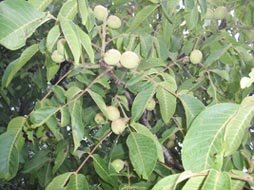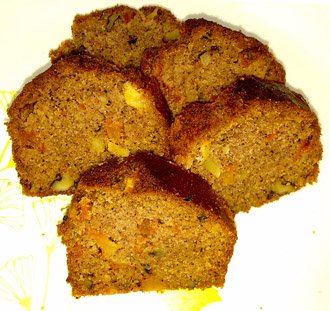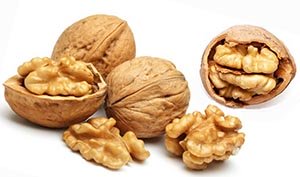Walnuts Nutrition facts
Walnuts are nutritious kernels obtained from the tree belonging to the Juglandaceae family, in the genus, Juglans. The nuts have been revered since ancient times as the symbol of intellectuality. Their bi-lobed kernels feature convoluted surfaces resembling that of a human brain! They are enriched with many health-benefiting nutrients, especially omega-3 fatty acids which are essential for optimum health.
Juglans species are medium-sized, semi-tropical, deciduous trees believed to be originating in the mountain ranges of the Central Asian or Southern Europe region.
| Walnut (Juglans regia) |
There are at least 30 different cultivars types of walnut grown world-over. However, only three traditional varieties grown for their commercial purposes are English or Persian walnut (Juglans regia), Black walnut (Juglans nigra), and the White or butternut walnut (Juglans cinerea). They are being cultivated at the commercial scale in the United States of America, Romania, France, Turkey, and China. After plantation, the tree takes approximately four years until it produces its first major crop.
 |
| Imamature, green walnuts on a J. regia tree. |
During a season, walnuts are ready for harvesting by August when their thick green hull (thin-cover) begins to open to expose light-brown, hard-shelled “walnut” inside. The whole fruit features a roughly spherical shape, about the size of a small lemon, weighing about 10-15 g, enclosing a single (bi-lobed) edible kernel inside.
Structurally, the walnut kernel consists of two uneven, off-white, corrugated lobes, covered in a papery thin, light brown membrane.
Walnut oil, distilled from kernels, is employed as a base or carrier oil in medicine, cooking, and aromatherapy.
Health Benefits of Walnuts
Walnuts are a rich source of energy, and hold many health-benefiting nutrients, minerals, antioxidants, and vitamins that are essential for wellbeing.
Monounsaturated fatty acids (about 72%) like oleic acid, and an omega-3 essential fatty acids such as linoleic acid, alpha-linolenic acid (ALA) and Arachidonic acids are present in abundance in the walnut kernels.
Nutrition experts recommend walnuts in the diet for their overall rewarding lipid profile of lowering LDL or “bad cholesterol” and boosting HDL or “good cholesterol” levels in the blood.
Research studies suggest that the Mediterranean diet that is rich in mono-unsaturated fatty acids and omega-3 fatty acids may help cut down risks of coronary artery disease, and strokes by favoring a healthy blood lipid profile.
Eating just a handful (25 g) of walnuts every day can provide about 90% of RDI (recommended daily intake) of omega-3 fatty acids.
Research studies suggest that n-3 fatty acids, through their virtue of anti-inflammatory effects, may help lower blood pressure, cut down on coronary artery disease and stroke risk, and offer protection from breast, colon, and prostate cancers.
Additionally, walnuts are endowed with several antioxidant phytochemicals including melatonin, ellagic acid, vitamin-E, carotenoids, and polyphenolic compounds. These compounds are known to have positive health effects against cancers, aging, inflammation, and neurological diseases.
Scientists at the University of Scranton, Pennsylvania, had recently concluded that walnuts possess one of the highest levels of polyphenolic antioxidants of all edible seeds and nuts. 100 g of the nuts carry 13,541 µmol TE (Trolox equivalents) of oxidant radical absorbance capacity (ORAC). Eating as many as six to seven walnuts a day could help stave off most of the disease-causing free radicals from the human body.
Further, they are an excellent source of vitamin-E, especially rich in γ -tocopherol; carry about 21 g per 100 g (about 140% of daily required levels). Vitamin E is a powerful lipid-soluble antioxidant essential for maintaining the integrity of cell membranes and skin health by protecting from harmful oxygen-induced free radicals.
They are also packed with several important B-complex groups of vitamins such as riboflavin, niacin, thiamin, pantothenic acid, vitamin B-6, and folates.
They also are a rich source of minerals such as manganese, copper, potassium, calcium, iron, magnesium, zinc, and selenium. Copper is a cofactor for many vital enzymes, including cytochrome C-oxidase and superoxide dismutase (other minerals that function as co-factors for this enzyme are manganese and zinc). Zinc is a co-factor in many enzymes that regulate growth and development, gonadal development, digestion, and nucleic acid synthesis. Selenium is an important micronutrient, which functions as a co-factor for antioxidant enzymes such as glutathione peroxidases.
Walnut oil has a deliciously nutty aroma and possesses excellent astringent properties. When applied locally, it tones up skin moisture and protects from dryness. It is also employed in cooking. In traditional medicines, it is used in massage therapy, aromatherapy, and as a “carrier or base oil” in the pharmaceutical, and cosmetic industries.
| Principle | Nutrient Value | Percent of RDA |
|---|---|---|
| Energy | 654 Kcal | 33% |
| Carbohydrates | 13.71 g | 11% |
| Protein | 15.23 g | 27% |
| Total Fat | 65.21 g | 217% |
| Cholesterol | 0 mg | 0% |
| Dietary Fiber | 6.7 g | 18% |
| Vitamins | ||
| Folates | 98 µg | 24% |
| Niacin | 1.125 mg | 7% |
| Pantothenic acid | 0.570 mg | 11% |
| Pyridoxine | 0.537 mg | 41% |
| Riboflavin | 0.150 mg | 11.5% |
| Thiamin | 0.341 mg | 28% |
| Vitamin A | 20 IU | 0.5% |
| Vitamin C | 1.3 mg | 2% |
| Vitamin E | 20.83 mg | 139% |
| Vitamin K | 2.7 µg | 2% |
| Electrolytes | ||
| Sodium | 2 mg | 0% |
| Potassium | 441 mg | 9% |
| Minerals | ||
| Calcium | 98 mg | 10% |
| Copper | 1.5 mg | 167% |
| Iron | 2.9 mg | 36% |
| Magnesium | 158 mg | 39.5% |
| Manganese | 3.4 mg | 148% |
| Phosphorus | 346 mg | 49% |
| Selenium | 4.9 µg | 9% |
| Zinc | 3.09 mg | 28% |
| Phyto-nutrients | ||
| Carotene-ß | 12 µg | -- |
| Crypto-xanthin-ß | 0 µg | -- |
| Lutein-zeaxanthin | 9 µg | -- |
Selection and storage
Walnuts can be available year-round in the markets. In the stores, you may get to see different forms of kernels put for sale; unshelled, shelled (without the shell), salted, sweetened, or ground, etc. Buy whole, “unshelled” nuts instead of processed ones.
While buying, look at the nuts that should feature a bright brown color, be compact, uniform in size, and feel heavy in hand. They should be free from cracks, mold, and spots, and rancid smell.
Unshelled walnuts can be placed in a cool, dry place for many months, whereas shelled (without the outer shell) kernels should be placed inside an airtight container and kept in the refrigerator to avoid them turning rancid.
Culinary uses
 |
| Apple-walnut bread. Courtesy: whologwhy |
Walnut kernels can be enjoyed as they are, without any seasonings or additions. Use a nutcracker machine to cut open its hard, outer shell. They can also be enjoyed roasted, salted, or sweetened.
The kernels are nutty yet pleasantly sweet in taste. Add them as toppings on yogurt, pizzas, pies, etc.
Crushed kernels often sprinkled over salads, desserts, particularly sundaes, and other cream-based preparations.
Candied walnuts can be added as seafood toppings.
They are used extensively in the confectionery, as an addition to biscuits, sweets, and cakes.
The nuts are also used to make walnut butter, which is quite popular, particularly among thepeanut allergy individuals.
In the Middle East, they added, along with almonds, dates, raisins,,etc., in Ramadan special pastry preparation, ma'amoul.
Safety profile
Walnut allergy is a type of hypersensitivity reaction to food substances prepared to use these nuts. It is due to prior sensitization of the immune system by allergens in the kernels, which may lead to severe physical symptoms like pain abdomen, vomiting, swelling of lips and throat leading to breathing difficulty, and chest congestion. Therefore, it is advised to avoid any food preparations that contain these nut products in the case of walnut-allergic individuals. (Medical disclaimer).
≺≺ Back to Nuts and seeds from Walnuts. Visit here for an impressive list of nuts with complete illustrations of their nutrition facts and health benefits.
≺≺ Back to Home page.
Further Resources:
Stanford School of Medicine Cancer information Page- Nutrition to Reduce Cancer Risk.
